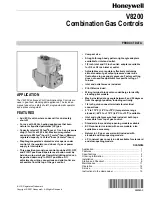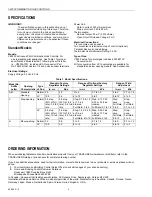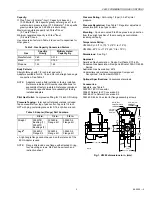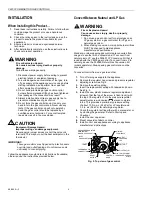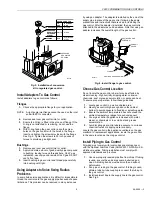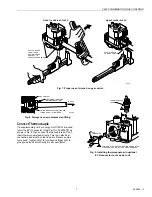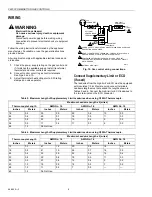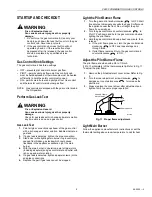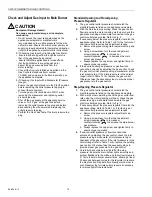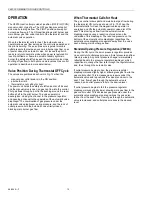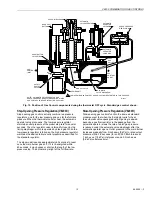
V8200 COMBINATION GAS CONTROLS
68-0045—3
10
Check and Adjust Gas Input to Main Burner
CAUTION
Equipment Damage Hazard.
Can cause equipment damage or incomplete
combustion.
1. Do not exceed the input rating stamped on the
appliance nameplate, or manufacturer’s
recommended burner orifice pressure for the size
orifice(s) used. Ensure the main burner primary air
supply is properly adjusted for complete combustion
(refer to the appliance manufacturer’s instructions).
2. If Checking Gas Input by Clocking the Gas Meter:
• Ensure that the only gas flow through the meter is
that of the appliance being tested.
• Ensure that other appliances are turned off and
that their pilot burners are extinguished (or
deduct their gas consumptions from the
meter reading).
• Convert the flow rate to Btuh as described in the
Gas Controls Handbook (form number
70-2602) and compare to the Btuh input rating on
the appliance nameplate.
3. If Checking Gas Input with a Manometer (Pressure
Gauge):
• Ensure the gas control knob is in the PILOT position
before removing the outlet pressure tap plug to
connect the manometer.
• Turn the gas control knob back to PILOT when
removing the manometer and replacing outlet
pressure tap plug.
• Shut off the gas supply at the appliance service
valve or, for LP gas, at the gas tank before
removing the outlet pressure tap plug and before
disconnecting the manometer and replacing the
outlet pressure tap plug.
• Perform the Gas Leak Test at the inlet pressure tap
plug.
Standard-Opening and Slow-Opening
Pressure Regulator
1.
The gas control outlet pressure should match the
manifold pressure listed on the appliance nameplate.
2.
With the main burner operating, check the gas control
flow rate using the meter clocking method or check the
gas pressure using a manometer connected to the gas
control outlet pressure tap. Refer to Fig. 2.
3.
If necessary, adjust the pressure regulator to match the
appliance rating. Refer to Table 7 or 8 for the factory set
nominal outlet pressures and adjustment ranges.
a. Remove the pressure regulator adjustment cap and
screw.
b. Using a screwdriver, turn the inner adjustment
screw clockwise
to increase or
counterclockwise
to decrease the main
burner gas pressure.
c. Always replace the cap screw and tighten firmly to
ensure proper operation.
4.
If the desired outlet gas pressure or gas flow rate
cannot be achieved by adjusting the gas control, check
the gas control inlet pressure using a manometer at the
inlet pressure tap. If the inlet pressure is in the normal
range (refer to Table 7 or 8), replace the gas control.
Otherwise, take the necessary steps to provide proper
gas pressure to the gas control.
Step-Opening Pressure Regulator
1.
The gas control outlet pressure should match the
manifold pressure listed on the appliance nameplate.
2.
With main burner operating, check the gas control flow
rate using the meter clocking method or check the gas
pressure using a manometer connected to the gas
control outlet pressure tap. Refer to Fig. 2.
3.
If necessary, adjust the pressure regulator to match the
appliance rating. Refer to Table 7 or 8 for factory set
nominal outlet pressures and adjustment ranges.
a. Remove the pressure regulator adjustment cap
screw.
b. Using a screwdriver, turn the inner adjustment
screw clockwise
to increase or
counterclockwise
to decrease the main burner
gas pressure.
c. Always replace the cap screw and tighten firmly to
ensure proper operation.
4.
If desired outlet pressure or flow rate cannot be
achieved by adjusting the gas control, check the inlet
pressure using a manometer at inlet pressure tap or
upstream of the gas control. If the inlet pressure is in the
normal range (refer to Table 7 or 8), replace the existing
gas control. Otherwise, take the necessary steps to
provide proper gas pressure to the gas control.
5.
Carefully check main burner lightoff at the step
pressure. Ensure the main burner lights smoothly and
without flashback to the orifice and that all ports remain
lit. Cycle the main burner several times, allowing at least
30 seconds between cycles for the regulator to resume
the step function. Repeat after allowing main burner to
cool. Readjust the full rate outlet pressure if necessary
to improve lightoff characteristics.

